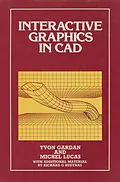In a society in which the use of information technology is becoming commonplace it is natural that pictures and images produced by elec tronic means should be increasing in importance as a means of com munication. Computer graphics have only recently come to the atten tion of the general public, mainly through animated drawings, advertise ments and video games. The quality of the pictures is often such that, unless informed of the fact, people are unaware that they are created with the help of computers. Some simulations, those developed in con nection with the space shuttle for example, represent a great and rapid progress. In industry, computer graphic techniques are used not only for the presentation of business data, but also in design and manufacture processes. Such computer-assisted systems are collectively represented by the acronym CAX. In CAD/CAM (computer-assisted design/manufacture), interactive graphic techniques have attained considerable importance. In CAD/CAM systems a dialogue can be established between the user and the machine using a variety of easy to operate communication devices. Due to the recent developments in hardware and software (for modelling, visual display, etc), a designer is now able to make decisions based on the information presented (plans, perspective drawings, graphics, etc) with the help of interactive, graphic techniques. These constitute the most visible and perhaps most spectacular aspect of CAD/CAM systems.
Inhalt
1 The role of graphics in computer-assisted design/manufacture.- 1.1 Design procedures.- 1.1.1 Designing a new product.- 1.1.2 Designing a standardized product.- 1.1.3 CAD/CAM - towards a definition.- 1.2 Graphics and CAD/CAM.- 1.3 Graphic processes in CAD/CAM.- 2 Components of a CAD/CAM system.- 2.1 General points.- 2.2 Hardware.- 2.2.1 General techniques.- 2.2.2 Passive visualization.- 2.2.3 Dynamic visualization.- 2.2.4 Communication devices.- 2.2.5 Graphic processors.- 2.3 Software.- 2.3.1 Basic structure of a CAD/CAM software system.- 2.3.2 Integration levels.- 2.3.3 Basic structure of CAD/CAM systems.- 3 Geometric modelling.- 3.1 General points.- 3.1.1 Principal types of model.- 3.1.2 Conditions affecting the quality of geometric modelling.- 3.1.3 Construction methods.- 3.1.4 Internal representation.- 3.2 Two-dimensional modelling.- 3.2.1 Manipulated parts.- 3.2.2 Construction of basic parts.- 3.2.3 Construction of complex elements.- 3.2.4 Examples of models.- 3.3 Three-dimensional modelling.- 3.3.1 Aims.- 3.3.2 Manipulated parts.- 3.3.3 Internal representation.- 3.3.4 Methods of construction.- 3.3.5 Examples of models.- 3.4 Communication between systems.- 3.5 Use of models.- 3.6 Conclusions.- 4 Visualization techniques.- 4.1 Different types of graphic representation.- 4.1.1 Tools of graphic representation.- 4.2 Comprehension graphics.- 4.2.1 Basic representations.- 4.2.2 Elimination of hidden parts.- 4.2.3 Animated graphics.- 4.3 Communication graphics.- 5 Dialogue techniques.- 5.1 General points.- 5.2 Elementary techniques.- 5.2.1 Use of a light pen.- 5.2.2 Use of an alphanumerical keyboard.- 5.2.3 Use of a function keyboard.- 5.2.4 Use of a graphic tablet.- 5.3 Functional aspects.- 5.3.1 Elementary functions.- 5.3.2 Composition of functions.- 5.3.3 Personalization of dialogue.- 5.4 Construction graphics.- 5.4.1 General points.- 5.4.2 Two-dimensional construction.- 5.4.3 Three-dimensional construction.- 6 Applications.- 6.1 Client plan of a ball-race.- 6.2 Design and manufacture of wooden shutterings.- 6.3 Installation of a drainage system.- 6.4 Electronics design.- 6.5 Design of circuit-breaker mechanisms.- 6.6 Architectural design.- 6.7 Structural installation.- 6.8 Studies relating to the construction of power stations.- 6.9 Design and production of automobile body-work.- 6.10 Design of turbines.- 7 The Finite element method.- 7.1 General points.- 7.1.1 Methodology.- 7.1.2 Range of design applications.- 7.1.3 Basis for the utilization of interactive graphics.- 7.2 Applications in structural analysis.- 7.2.1 Basic considerations.- 7.2.2 Examining some simple models.- 7.2.3 Element formulations.- 7.3 The solution procedure.- 7.3.1 Defining the problem.- 7.3.2 Modelling the problem.- 7.3.3 The input data.- 7.3.4 The output results.- 7.4. The role of interactive graphics.- 7.4.1 Preprocessing - Creating the model interactively.- 7.4.2 Postprocessing - Reviewing the finite element results interactively.
